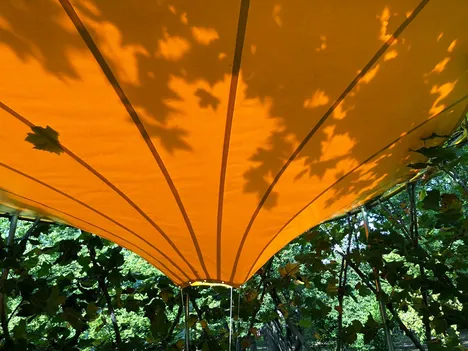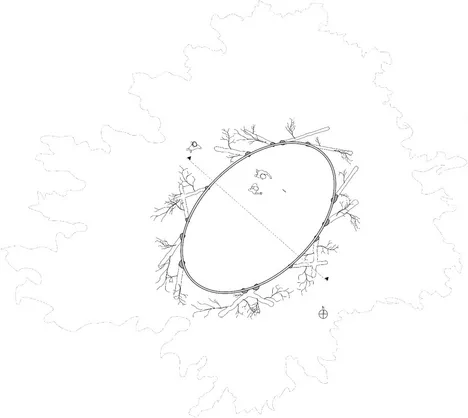






BAUBOTANISCHER PAVILLON in the botanical garden Freiburg
The scientific objective of the project "baubotanischer Pavillon" is a long-term observation of a building with the help of photogrammetric methods, which should further develop the maintenance and development concept, as well as make predictions and calculations of the bearing capacity possible.
The elliptically arranged living structure carries a membrane roof as protection against sun and weather and thus forms a space with green walls. The stainless steel ring holding the membrane is to grow together with the living structure by guiding a trunk and a side shoot around the pipe so that it is overrun. For this purpose, the plants are screwed together at the crossing points to initiate inosculation.
In 2007 the first version of the pavilion made of wicker (salix viminalis) was realized as a grid structure. This was directly able to support a stainless steel ring and the membrane connected to it as the roof of the pavilion. After it was noticed that the stability of the pavilion was steadily decreasing due to the death of some plants and parasite infestation, it was decided to renew the pavilion from the ground up.
The re-design, initiated in 2017, solves the above mentioned problems by using plane trees (platanus acerifolia) as the basic structure. This robust and durable tree species allows a lower plant density in combination with temporary supports. The implementation is now taking place step by step: While the stainless steel ring is supported, the trees can establish themselves on the site. Taking into account the development of the plants, the membrane can then be attached first and the supports removed last.
______________________________________
Design and implementation of the redesign:
Ferdinand Ludwig, Lorenz Boigner
Location and cooperation partners:
Botanischer Garten der Albert-Ludwig-Universität Freiburg
Plant species:
Platane (platanus acerifolia), zuvor: Korbweide (salix viminalis)
Financing:
Botanischer Garten der Albert-Ludwig-Universität Freiburg,
Freunde des Botanischen Gartens,
Technische Universität München